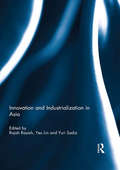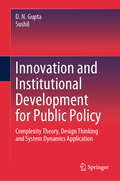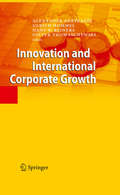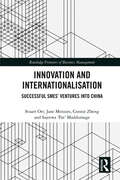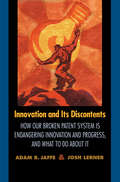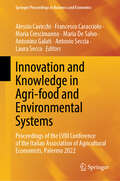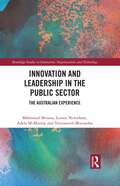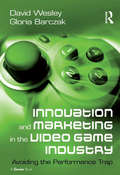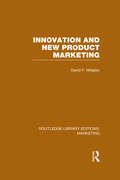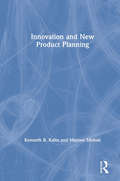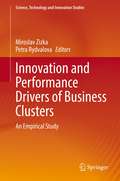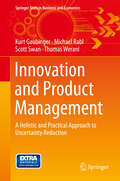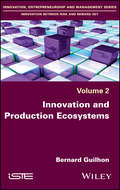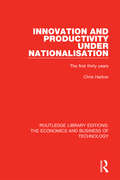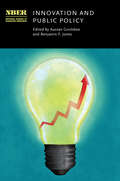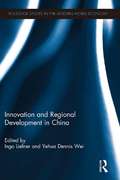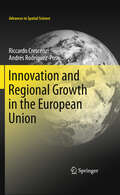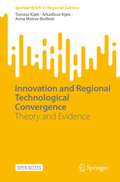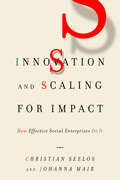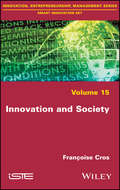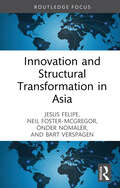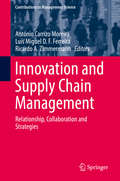- Table View
- List View
Innovation and Industrialization in Asia
by Rajah Rasiah Yeo Lin Yuri SadoiExisting accounts of East Asia’s meteoric growth and structural change has either been explained as one dictated essentially by markets with strong macroeconomic fundamentals, or a consequence of proactive governments. This book departs from such a dichotomy by examining inductively the drivers of the experiences. Given the evolutionary treatment of each economic good and service as different, this book examines technological catch up with a strong focus on the industries contributing significantly to the economic growth of the countries selected in Asia. The evidence produced supports the evolutionary logic of macro, meso and micro interactions between several institutions, depending on the actors involved, structural location and typology of taxonomies and trajectories. The book carefully picks out experiences from the populous economies of China, India and Indonesia, the high income economies of Korea and Taiwan, the middle income economies of Malaysia and Thailand, and the transitional least developed country of Myanmar. Chapters 1-7 of this book were originally published as a special issue of Journal of the Asia Pacific Economy.
Innovation and Institutional Development for Public Policy: Complexity Theory, Design Thinking and System Dynamics Application
by D. N. Gupta SushilThis book offers a comprehensive perspective on policy theories, policy formulation and implementation, and alternative paradigm for dealing with complex social and economic systems. It presents insights into policies on major development sectors, including health, education, urbanization, climate change, innovation, advanced manufacturing, and economic growth. It delves into why public policies matter more than resources and are crucial for shaping the future of a country. It attempts a pioneering effort and delineates a complexity theory framework to deal with uncertainty, nonlinearity, emergence, and evolution. It comprises systems thinking, design thinking, complexity thinking, and tools for complexity analysis. Applicable to a policy system, economy, business, and organization, the complexity theory relies on phenomena like emergence, self-organizing property, adaptation, coevolution, and path dependency, in a clear departure from reductionism and Newtonian paradigm. Through academic rigor, it makes a convincing case for better understanding of application of complexity theory. It covers real-world examples and case studies related to evolution of economies of silicon valleys – Bengaluru (India) and San Francisco Bay (USA). These cases underscore the essentiality of complexity theory. In terms of policy formulations, the book contains a policy design framework covering the science of policymaking, innovative approaches, and methodology for policy design. To deal with dynamic systems, it includes a step-by-step guide for the application of system dynamics. It articulates alternative paradigm – adaptive policies and policy design; alternative theory – complexity theory; and new public organizations and institutional development for meeting the challenges of the 21st century. Aiming to reduce fuzziness, the book combines both researcher’s in-depth analysis as well as practitioner’s perspective, thus serving as a vital read for scholars of public policy, management, and economics. It emphasizes the primacy of policy process to discern deep understanding from the ground and to integrate micro-level realities and macro-level requirements. It argues for change from Weberian bureaucratic model to adaptive approaches and recommends policy system reforms, highlighting that countries should make the right policy choices early to steer ahead. In doing so, the book serves the requirements of policymakers and thought leaders.
Innovation and International Corporate Growth
by Dieter Thomaschewski Alexander Gerybadze Ulrich Hommel Hans W. ReinersResearch and development (R&D) as well as innovation are the drivers of change and the key determinants of growth in many industry and service sectors. In spite of the financial turmoil and restructuring of the world economy after 2008, investment in R&D is expected to grow further. Innovation competence will continue to be a major success factor for internationally operating companies. The book presents a state-of-the-art account of innovation management and the role of R&D and innovation strategy for corporate growth and renewal. It follows a top-down approach starting from corporate strategy, and describes the effective integration of corporate R&D, business unit projects and operational performance improvements. The book offers portraits of leading innovators and high-performing corporations and provides a rich collection of best-practice examples.
Innovation and Internationalisation: Successful SMEs’ Ventures into China (Routledge Frontiers of Business Management)
by Stuart Orr Jane Menzies Connie Zheng Sajeewa 'Pat' MaddumageThis book provides a comprehensive examination of the many factors that influence the internationalisation of SMEs into China. SMEs represent more than 50 percent of the economic activity and employment in China. This book explores the experiences of SMEs that have internationalised to China from Australia. Australian SMEs are at the forefront of foreign SMEs in China with over 5000 Australian SMEs currently operating in China and a long history of association. The book is unique in that it presents a multidisciplinary perspective of the subject, considering seven different discipline perspectives (internationalisation, innovation, entrepreneurship, networks, resources, human resource management and barriers and liabilities). This makes the book one of the most comprehensive treatments of internationalisation to China so far. Each chapter in the book deals with a different perspective and includes own separate analysis. The chapters commence with a consideration of the current knowledge on internationalising to China for each perspective, analyse the interviews of representatives of 35 SMEs operating in China and then draw conclusions which are relevant to students, scholars and professionals. Each chapter includes extensive examples from the interviews. This integrated book is particularly useful for small business owners, international business management consultants, instructors and students.
Innovation and Its Discontents: How Our Broken Patent System is Endangering Innovation and Progress, and What to Do About It
by Adam B. Jaffe Josh LernerThe United States patent system has become sand rather than lubricant in the wheels of American progress. Such is the premise behind this provocative and timely book by two of the nation's leading experts on patents and economic innovation. Innovation and Its Discontents tells the story of how recent changes in patenting--an institutional process that was created to nurture innovation--have wreaked havoc on innovators, businesses, and economic productivity. Jaffe and Lerner, who have spent the past two decades studying the patent system, show how legal changes initiated in the 1980s converted the system from a stimulator of innovation to a creator of litigation and uncertainty that threatens the innovation process itself. In one telling vignette, Jaffe and Lerner cite a patent litigation campaign brought by a a semi-conductor chip designer that claims control of an entire category of computer memory chips. The firm's claims are based on a modest 15-year old invention, whose scope and influenced were broadened by secretly manipulating an industry-wide cooperative standard-setting body. Such cases are largely the result of two changes in the patent climate, Jaffe and Lerner contend. First, new laws have made it easier for businesses and inventors to secure patents on products of all kinds, and second, the laws have tilted the table to favor patent holders, no matter how tenuous their claims. After analyzing the economic incentives created by the current policies, Jaffe and Lerner suggest a three-pronged solution for restoring the patent system: create incentives to motivate parties who have information about the novelty of a patent; provide multiple levels of patent review; and replace juries with judges and special masters to preside over certain aspects of infringement cases. Well-argued and engagingly written, Innovation and Its Discontents offers a fresh approach for enhancing both the nation's creativity and its economic growth.
Innovation and Knowledge in Agri-food and Environmental Systems: Proceedings of the LVIII Conference of the Italian Association of Agricultural Economists, Palermo 2022 (Springer Proceedings in Business and Economics)
by Alessio Cavicchi Francesco Caracciolo Maria Crescimanno Maria De Salvo Antonino Galati Antonio Seccia Laura SeccoThis book contains selected papers from the LVIII Conference of the Italian Association of Agricultural Economists which was held in Palermo, Italy, from 29 to 30 September 2022. The chapters discuss challenges and opportunities under the turbulent socio-economic and political situation caused by the COVID-19 pandemic and the ongoing conflict between Russia and Ukraine. It includes topics such as assessment methods and tools for governance of natural resources, ecological and digital transition in agriculture, agri-food and forest companies, markets and consumer analysis, recovery and resilience in rural areas, as well as strategies for the creation of sustainable value chains in agri-food and forest sectors.
Innovation and Leadership in the Public Sector: The Australian Experience (Routledge Studies in Innovation, Organizations and Technology)
by Mahmoud Moussa Leonie Newnham Adela McMurray Nuttawuth MuenjohnUsing empirical data, this book uniquely presents the dynamics of innovation within public sector organisations and identifies the most crucial factors that promote innovation or the determinants that enhance innovation activities. It presents a macro and micro analysis of workplace innovation in the Australian public sector written by a combination of practitioners and academics to provide both theoretical and practical insights. The book reviews the relationship between culture and workplace innovation as a multi-dimensional, subjective and context specific phenomenon operating dynamically as organisational innovation, organisational climate for innovation, team and individual innovation. It identifies a variance in the perception of workplace innovation and organisational culture between public sector employees with different demographic and employment characteristics. The demographic and employment characteristics confirm that employees in a Public Sector Department of State exhibit significant differences between various groups in how culture impacts on workplace innovation. This knowledge assists practitioners in developing positive cultural environments that support the development of workplace innovation and raise awareness in considering the differences within organisations caused by an individual’s characteristics. Lastly, the book reviews public organisations around the world and provides a cross cultural comparison of public sector innovation and leadership. This includes a review of the major forms of public sector systems in operation and how this relates to innovation and leadership. Innovation and Leadership in the Public Sector is written for academics and students interested in the public sector innovation field. It’s suitable for both graduate and undergraduate students and researchers in the fields of public administration, management policy, organisational behaviour, human resources management (HRM) and human resources development (HRD) courses. Additionally, this book is suitable for middle-to-senior-level administrators or managers who wish to develop more innovative public sector organisations.
Innovation and Leadership in the Public Sector: The Australian Experience (Routledge Studies in Innovation, Organizations and Technology)
by Mahmoud Moussa Leonie Newnham Adela McMurray Nuttawuth MuenjohnUsing empirical data, this book uniquely presents the dynamics of innovation within public sector organisations and identifies the most crucial factors that promote innovation or the determinants that enhance innovation activities. It presents a macro and micro analysis of workplace innovation in the Australian public sector written by a combination of practitioners and academics to provide both theoretical and practical insights.The book reviews the relationship between culture and workplace innovation as a multi-dimensional, subjective and context-specific phenomenon operating dynamically as organisational innovation, organisational climate for innovation, team and individual innovation. It identifies a variance in the perception of workplace innovation and organisational culture between public sector employees with different demographic and employment characteristics. The demographic and employment characteristics confirm that employees in a Public Sector Department of State exhibit significant differences between various groups in how culture impacts on workplace innovation. This knowledge assists practitioners in developing positive cultural environments that support the development of workplace innovation and raise awareness in considering the differences within organisations caused by an individual’s characteristics. Lastly, the book reviews public organisations around the world and provides a cross cultural comparison of public sector innovation and leadership. This includes a review of the major forms of public sector systems in operation and how this relates to innovation and leadership.Innovation and Leadership in the Public Sector is written for academics and students interested in the public sector innovation field. It’s suitable for both graduate and undergraduate students and researchers in the fields of public administration, management policy, organisational behaviour, human resources management (HRM) and human resources development (HRD) courses. Additionally, this book is suitable for middle-to-senior-level administrators or managers who wish to develop more innovative public sector organisations.
Innovation and Marketing in the Pharmaceutical Industry
by Min Ding Jehoshua Eliashberg Stefan StremerschThe pharmaceutical industry is one of today's most dynamic and complex industries, involving commercialization of cutting-edge scientific research, a huge web of stakeholders (from investors to doctors), multi-stage supply chains, fierce competition in the race to market, and a challenging regulatory environment. The stakes are high, with each new product raising the prospect of spectacular success--or failure. Worldwide revenues are approaching $1 trillion; in the U. S. alone, marketing for pharmaceutical products is, itself, a multi-billion dollar industry. In this volume, the editors showcase contributions from experts around the world to capture the state of the art in research, analysis, and practice, and covering the full spectrum of topics relating to innovation and marketing, including R&D, promotion, pricing, branding, competitive strategy, and portfolio management. Chapters include such features as: · An extensive literature review, including coverage of research from fields other than marketing · an overview of how practitioners have addressed the topic · introduction of relevant analytical tools, such as statistics and ethnographic studies · suggestions for further research by scholars and students The result is a comprehensive, state-of-the-art resource that will be of interest to researchers, policymakers, and practitioners, alike.
Innovation and Marketing in the Video Game Industry: Avoiding the Performance Trap
by David Wesley Gloria BarczakVideo games have had a greater impact on our society than almost any other leisure activity. They not only consume a large portion of our free time, they influence cultural trends, drive microprocessor development, and help train pilots and soldiers. Now, with the Nintendo Wii and DS, they are helping people stay fit, facilitating rehabilitation, and creating new learning opportunities. Innovation has played a major role in the long term success of the video game industry, as software developers and hardware engineers attempt to design products that meet the needs of ever widening segments of the population. At the same time, companies with the most advanced products are often proving to be less successful than their competitors. Innovation and Marketing in the Video Game Industry identifies patterns that will help engineers, developers, and marketing executives to formulate better business strategies and successfully bring new products to market. Readers will also discover how some video game companies are challenging normal industry rules by using radical innovations to attract new customers. Finally, this revealing book sheds light on why some innovations have attracted legions of followers among populations that have never before been viewed as gamers, including parents and senior citizens and how video games have come to be used in a variety of socially beneficial ways. David Wesley and Gloria Barczak's comparison of product features, marketing strategies, and the supply chain will appeal to marketing professionals, business managers, and product design engineers in technology intensive industries, to government officials who are under increasing pressure to understand and regulate video games, and to anyone who wants to understand the inner workings of one of the most important industries to emerge in modern times. In addition, as video games become an ever more pervasive aspect of media entertainment, managers from companies of all stripes need to understand video gaming as a way to reach potential customers.
Innovation and New Product Marketing (Routledge Library Editions: Marketing)
by David F. MidgleyThis volume formulates and presents a general theory of innovative behaviour which is applicable to diverse market situations. Having provided some support for the theory, the author demonstrates how it can be usefully applied by indicating which management techniques are relevant to new product management and which are not. The author suggests certain systematic procedures by which an organisation can radically improve both its short and long run chances of launching successful new products.
Innovation and New Product Planning
by Kenneth B. Kahn Mayoor MohanThis practical book introduces readers to the essential business aspects of innovation and new product planning. The product planning process is discussed across two broad themes: product development and product management. Importantly, the book emphasizes the 21st-century strategic and creative mindset necessary to drive business innovation activities in a concise, yet comprehensive manner. The book delves into the front end of innovation and formal product development activities, examining the topics of opportunity identification, concept generation and evaluation, technical development, product design, testing, launch strategies, product management, life cycle management, brand management, and vital elements for international success. There are stand-alone notes that serve to apprise readers on related topics such as the use of agile product development methodologies, the formation of business entities, and recommended best practices for new product development. The book excels at providing relevant examples and applied tools that augment the concepts to offer valuable connections to real-world product planning efforts. This book is particularly useful as a guide to learning the fundamental concepts and strategies associated with innovation and new product planning. Among student audiences, upper-level undergraduate and first-year graduate students are likely to benefit as the book embraces its position to serve as a primer on product development and management.
Innovation and Performance Drivers of Business Clusters: An Empirical Study (Science, Technology and Innovation Studies)
by Miroslav Zizka Petra RydvalovaThis book highlights the importance of clusters for the competitiveness of companies and is divided into three interrelated parts. The first part focuses on localization economics, cluster theory, the role of innovation, and innovation partnerships in cluster formations. The second part of the volume presents original research carried out from 2018 to 2020 in the field of both natural clusters and organized clusters. In addition to examining the impact of cluster membership, the contributions also focus on additional factors that may affect the financial performance of companies. In the third part, an additional survey and case studies are presented, to examine the specifics of family businesses in selected industrial districts of the textile, glass, and jewelry industries. A broader overview of the development of dominant industries in the selected districts is provided, for an easier understanding of the relationships of competition among companies and locations in the business clusters. The book evaluates implications for microeconomic and macroeconomic policies and provides proposals for corporate inter-organizational behavior.This volume addresses scholars and researchers of economics, business, and management, as well as policy-makers and practitioners interested in a better understanding of innovation and performance drivers of business clusters.
Innovation and Product Management
by Kurt Gaubinger Michael Rabl Scott Swan Thomas WeraniMarketplace complexity and dynamics create an environment that increases the uncertainty of innovation activities. In this context systematic management of innovation and product management are increasingly important for company success. This book presents the fundamentals of innovation and product management and introduces the reader to a holistic process model with particular focus on innovation and uncertainty. This integrated consideration of innovation management and product innovation within an interdisciplinary approach represents a unique characteristic of this book. The book is designed to address the needs of managers who want a practical but well-researched guide to innovation and product management. Graduate and advanced undergraduate students would also find the chapters in this book particularly useful.
Innovation and Production Ecosystems
by Bernard Guilhon“We do not know where Silicon Valley is really located”, Feldman writes, because these types of organization, when they are dynamic, are moving and fluid. Innovation and production ecosystems or clusters are proliferating today because they seem to be adapted to the demands of innovation, growth and employment. The process leading to their institutionalization escapes a summary analysis of the behavior triggered by monetary incentives or, at the very least, makes it richer. The relational aspect becomes predominant, the interactions between the participants testify to the difficulty of separating the geographical and social dimensions. In the most prominent American clusters, public/private linkages and the building of social links express the centrality of networks in the innovation process. The European vision seeks to articulate entrepreneurial discoveries with vertical public interventions. The competitiveness poles in France suffer from the fact that public choices seem to be torn between two contradictory objectives: efficiency and equity.
Innovation and Productivity Under Nationalisation: The First Thirty Years (Routledge Library Editions: The Economics and Business of Technology #18)
by Chris HarlowOriginally published in 1977, this book examines the choice of new production techniques available to the publicly owned industries during their first thirty years and the effectiveness with which these techniques were put to use. In the heat of political debate over nationalisation the basic economic issues involved are frequently obscured: this volume shows how the opportunity to gain advantages of scale offered by nationalisation and the new techniques which scale made possible were pursued by the public corporations through policies of innovation and the diffusion of technical advances.
Innovation and Public Policy (National Bureau of Economic Research Conference Report)
by Austan Goolsbee Benjamin F. JonesUsing the latest empirical and conceptual research for readers in economics, business, and policy, this volume surveys the key components of innovation policy and the social returns to innovation investment. In advanced economies like the United States, innovation has long been recognized as a central force for increasing economic prosperity and human welfare. Today, the US government promotes innovation through various mechanisms, including tax credits for private-sector research, grant support for basic and applied research, and institutions like the Small Business Innovation Research Program of the National Science Foundation. Drawing on the latest empirical and conceptual research, Innovation and Public Policy surveys the key components of innovation policy and the social returns to innovation investment. It examines mechanisms that can advance the pace of invention and innovative activity, including expanding the research workforce through schooling and immigration policy and funding basic research. It also considers scientific grant systems for funding basic research, including those at institutions like the National Institutes of Health and the National Science Foundation, and investigates the role of entrepreneurship policy and of other institutions that promote an environment conducive to scientific breakthroughs.
Innovation and Public Policy (National Bureau of Economic Research Conference Report)
by Austan Goolsbee Benjamin F. JonesUsing the latest empirical and conceptual research for readers in economics, business, and policy, this volume surveys the key components of innovation policy and the social returns to innovation investment. In advanced economies like the United States, innovation has long been recognized as a central force for increasing economic prosperity and human welfare. Today, the US government promotes innovation through various mechanisms, including tax credits for private-sector research, grant support for basic and applied research, and institutions like the Small Business Innovation Research Program of the National Science Foundation. Drawing on the latest empirical and conceptual research, Innovation and Public Policy surveys the key components of innovation policy and the social returns to innovation investment. It examines mechanisms that can advance the pace of invention and innovative activity, including expanding the research workforce through schooling and immigration policy and funding basic research. It also considers scientific grant systems for funding basic research, including those at institutions like the National Institutes of Health and the National Science Foundation, and investigates the role of entrepreneurship policy and of other institutions that promote an environment conducive to scientific breakthroughs.
Innovation and Regional Development in China (Routledge Studies in the Modern World Economy #120)
by Ingo Liefner Yehua Dennis WeiAlthough China is now the ‘factory of the world’, there is no reason to expect that it will always be content with manufacturing labor-intensive goods for foreign corporations. Scholars must now ask: What is the current level of innovation in China? And how can we face this challenge and renovate industrial production and innovation capacities in developed countries? This edited volume investigates the unique characteristics of Chinese innovation and regional development, China’s policy framework, and the role that transnational corporations play in China’s increasing innovation activities. This book contributes to the heated debate regarding pathways for technology progress and regional development in developing countries, and identifies the ways in which local production networks respond to different configurations of external linkages. Linking patterns of global and local production networks with the trajectories of technology development and regional development allows the authors to theorize and test whether, and how, particular configurations of production networks generate divergent long-term local productivity growth and technological development outcomes. Innovation and Regional Development in China will be of interest to geographers, economists, China specialists, development specialists, and scholars working on innovation and regional development in developing areas and transition countries.
Innovation and Regional Growth in the European Union
by Andrés Rodríguez-Pose Riccardo CrescenziThis book investigates the EU's regional growth dynamics and, in particular, the reasons why peripheral and socio-economically disadvantaged areas have persistently failed to catch up with the rest of the Union. It shows that the capability of the knowledge-based growth model to deliver its expected benefits to these areas crucially depends on tackling a specific set of socio-institutional factors which prevents innovation from being effectively translated into economic growth. The book takes an eclectic approach to the territorial genesis of innovation and regional growth by combining different theoretical strands into one model of empirical analysis covering the whole EU-25. An in-depth comparative analysis with the United States is also included, providing significant insights into the distinctive features of the European process of innovation and its territorial determinants. The evidence produced in the book is extensively applied to the analysis of EU development policies.
Innovation and Regional Technological Convergence: Theory and Evidence (SpringerBriefs in Regional Science)
by Tomasz Kijek Arkadiusz Kijek Anna Matras-BolibokThis open access book explores the role of innovation in technological convergence processes in the EU regional space and shifts the focus from absolute and conditional income convergence to technological convergence and its determinants. Presenting new theoretical and empirical evidence on the determinants and trajectory of the EU region’s development and convergence, this book will appeal to scholars of economics and regional science, as well as practitioners and policymakers interested in the policy implications of regional technological convergence. The presented findings will also contribute to the development of the knowledge-based economy paradigm in the regional context.
Innovation and Scaling for Impact: How Effective Social Enterprises Do It
by Johanna Mair Christian SeelosInnovation and Scaling for Impact forces us to reassess how social sector organizations create value. Drawing on a decade of research, Christian Seelos and Johanna Mair transcend widely held misconceptions, getting to the core of what a sound impact strategy entails in the nonprofit world. They reveal an overlooked nexus between investments that might not pan out (innovation) and expansion based on existing strengths (scaling). In the process, it becomes clear that managing this tension is a difficult balancing act that fundamentally defines an organization and its impact. The authors examine innovation pathologies that can derail organizations by thwarting their efforts to juggle these imperatives. Then, through four rich case studies, they detail innovation archetypes that effectively sidestep these pathologies and blend innovation with scaling. Readers will come away with conceptual models to drive progress in the social sector and tools for defining the future of their organizations.
Innovation and Society: Education And Formation
by Françoise CrosThis book takes stock of the state of the question on innovation in a particular area of education and training. But for this it must be noted that economists have appropriated the notion since Schumpeter and have constrained to think innovation in professions of intervention on others as if they were products to be delivered to the customer as quickly and the best (frugal innovation). Here the author brings a nuance and demonstrates the specificity of innovations in "soft" areas, their richness, while drawing the reader to caution and criticism because any innovation is not good in itself: it can Produce adverse effects in the medium and long term. The author proposes two supports for innovation: on the one hand the approach by its most objective evaluation which itself induces an innovation in its evaluation and, on the other hand, an approach to values and therefore to philosophy of the desired future man. A detour on the history of innovation, on its international approaches, on the imaginary investments it is often the object of (with a nuance of utopia) makes it possible to understand why innovation has been a means To drive the reforms and to convince people for a better future.
Innovation and Structural Transformation in Asia
by Jesus Felipe Neil Foster-McGregor Bart Verspagen Önder NomalerThis book explores recent drivers of Asia’s growth and economic development. The analysis is based on a database created by the authors. It covers a large number of economies, including 39 from Asia for the period 1990–2020.The database and the analysis in the book use novel indicators of development. It is structured along four areas: productivity and structural change, global value chains (GVCs), economic complexity, and the Fourth Industrial Revolution (4IR). The book offers insights into current economic performance and future prospects. It shows great heterogeneity across the region, highlighting a range of development experiences. Each chapter contains an accessible methodological section of the concepts used, explaining the construction of indicators and how they should be interpreted.The book will interest scholars of Asian economics, structural transformation, productivity, GVCs, complexity, and 4IR studies. The publicly available database will also appeal to policymakers and researchers interested in data analysis.
Innovation and Supply Chain Management: Relationship, Collaboration And Strategies (Contributions To Management Science Series)
by António Carrizo Moreira Ricardo A. Zimmermann Luís Miguel FerreiraThis book examines key issues, challenges, opportunities and trends in innovation processes and supply chain management. It proposes ways for organizations to improve their performance by developing business strategies, establishing business innovation activities, and aligning business and innovation activities among firms. Further, it showcases and analyzes the implementation of inter- and intra-organizational process improvement activities and the implementation of organizational innovation solutions to address new product and process-related collaborative relationships across the supply chain. The book is useful for researchers, academics and professionals, presenting some of the most advanced research, concepts, and case studies on the relationship between innovation and supply chain.
